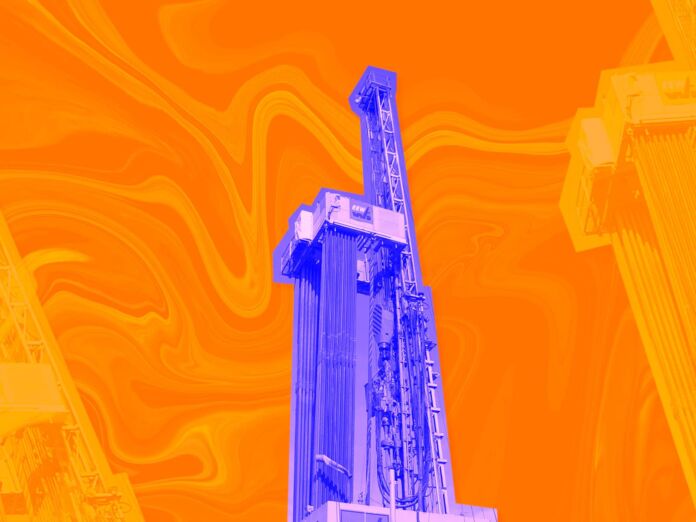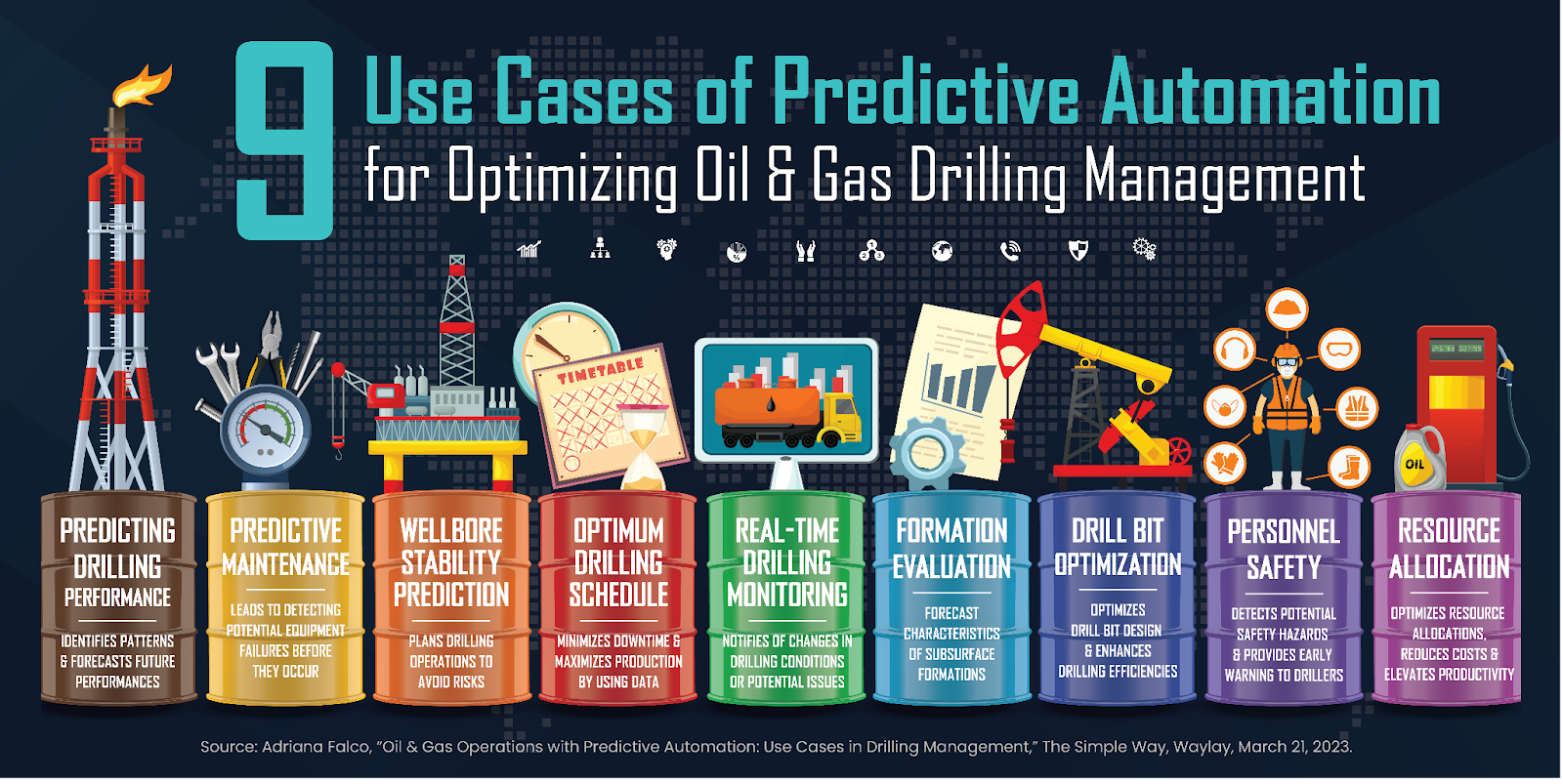
Oil and gas companies are constantly looking for ways to increase efficiency and reduce costs in their operations. One of the most promising ways to achieve these goals is through the use of predictive automation. Predictive automation combines the power of machine learning (ML) and artificial intelligence (AI) to analyze vast amounts of data, which now exceeds 10TB of data per day for a single well, and makes accurate predictions about future events. In the oil and gas industry, this technology has a wide range of applications, from predicting equipment failure to optimizing production schedules. But does this sound too similar to automation? Let’s take a look at the difference between automation and predictive automation, as well as some of the use cases for drilling management.
“Predictive automation combines the power of machine learning (ML) and artificial intelligence (AI) to analyze vast amounts of data, which now exceeds 10TB of data per day for a single well, and makes accurate predictions about future events.”
-Waylay
Automation vs. Predictive Automation
In the oil and gas industry, automation typically involves the use of machines and software to perform routine tasks such as data entry, monitoring of production parameters, and control of equipment. This helps to reduce human error, increase efficiency, and improve safety.
Predictive automation, on the other hand, utilizes advanced data analytics, ML, and AI algorithms to analyze vast amounts of data and to make accurate predictions in real time. This can include analyzing geological data to predict wellbore instability, monitoring equipment performance to detect potential failures, and analyzing drilling performance data to optimize drilling parameters.
In essence, while automation in the oil and gas industry automates routine tasks, predictive automation utilizes advanced algorithms to anticipate issues and optimize operations in real time, improving efficiency, reducing downtime, and enhancing safety.
Prediction Automation in Drilling Management
One specific use case for oil and gas predictive automation is in the management of drilling operations. Drilling is a complex process that involves many different variables, such as the geological characteristics of the well, the equipment being used, and the weather conditions at the site.
By using predictive automation to analyze data from various sources, drilling companies can make more informed decisions about when and where to drill, and how to optimize the drilling process for maximum efficiency.

Use Cases of Prediction Automation in O&G Drilling
The following are use cases as to how predictive automation can be used in drilling operations:
Predicting Drilling Performance
By analyzing data on drilling performance, including drilling rate, torque, and pressure, predictive automation can identify patterns and forecast future performance. This allows drillers to optimize drilling parameters and make immediate adjustments in real time, resulting in enhanced efficiency and minimized downtime.
Predictive Maintenance
Monitoring equipment performance, such as vibration, temperature, and fluid flow with predictive automation can lead to detecting potential equipment failures before they occur. This can help drillers schedule maintenance and avoid unexpected downtime.
Wellbore Stability Prediction
Predictive automation can analyze geological data and drilling performance data to predict the likelihood of wellbore instability, such as borehole collapse or wellbore breakouts. This can help drillers plan drilling operations to avoid these risks.
Optimum Drilling Schedule
Additionally, drilling companies can optimize their drilling schedule to minimize downtime and maximize production by using the data to determine how the well will respond to different drilling techniques and environmental conditions.
Real-Time Drilling Monitoring
Utilizing sensors and data analytics, predictive automation can monitor drilling operations in real time and promptly notify drillers of any modifications in drilling conditions or potential issues. This empowers drillers to swiftly adapt their drilling parameters, resulting in the prevention of costly drilling failures.
Formation Evaluation
By examining geological data, including well logs and seismic data, predictive automation can forecast the characteristics of subsurface formations. This enables drillers to fine-tune their drilling parameters and evade drilling into troublesome formations.
Drill Bit Optimization
By reviewing data related to drill bit wear and drilling performance in real-time, predictive automation can optimize drill bit design and enhance drilling efficiency. By reducing drilling costs and improving drilling performance, drillers can significantly benefit from this technology.
Personnel Safety
Analyzing data on personnel behavior and equipment usage via predictive automation can detect potential safety hazards and provide early warning to drillers. This can help drillers improve safety practices and reduce the risk of accidents.
Resource Allocation
Through analysis of data on drilling performance and resource usage, predictive automation can optimize resource allocation, such as drilling fluid and equipment, and enhance efficiency. This empowers drillers to reduce costs and elevate productivity.
Additional Perks
In addition to the benefits mentioned above, the use of predictive automation in drilling management can also lead to more accurate forecasting, improved cost estimation, and better decision-making. By analyzing data on equipment performance and drilling efficiency, drilling companies can make precise predictions about the costs and timeline for completing a project.
Moreover, predictive automation can help drilling companies optimize their use of resources. For example, by analyzing data on fuel consumption, drilling companies can identify opportunities to reduce fuel usage and lower costs. Additionally, by analyzing data on the availability and location of equipment and personnel, drilling companies can better allocate resources to ensure that they are being used efficiently.
Lastly, the benefits of predictive automation are not limited to drilling operations alone. In fact, the technology has the potential to transform the entire oil and gas industry. For example, predictive automation can be used to optimize pipeline operations, monitor the health of offshore platforms, and improve the safety and efficiency of refinery processes.
What the Experts Are Saying
“Predictive analytics and automation can help [oil and gas companies] reduce downtime, maximize production, improve safety, and reduce costs,” said Andrea Rossi, Global Head of Oil and Gas at Wipro Limited in Bengaluru, India.
“Predictive automation is a game-changer for the oil and gas industry,” said John Smith, CEO of Oil and Gas Exploration Company. “By analyzing data in real-time and making accurate predictions about future events, drilling companies can optimize their operations to maximize efficiency, reduce costs, and improve safety. This technology has the potential to transform the way we do business and stay competitive in today’s market.”
“Applying analytics to operations can help oil and gas companies make sense of data from the field, reduce downtime, improve maintenance, increase production, and improve worker safety,” said Scott L. Byers, Global Head of Oil and Gas at Avanade based in Seattle, Washington.
“As the oil and gas industry faces increasing pressure to reduce its environmental impact, predictive automation is a key tool for achieving sustainability goals,” said Sarah Lee, Director of Sustainability at Energy Corporation. “By optimizing drilling schedules and reducing downtime, companies can minimize their carbon footprint and reduce waste. This technology is essential for staying ahead of the curve and meeting the demands of consumers and investors alike.”
“Automation and data analytics will continue to be essential components of successful oil and gas companies in the future,” said Arnaud Breuillac, President of Exploration and Production at Total S.A. headquartered in Paris, France.
“Predictive automation is the future of oil and gas operations,” said Mark Johnson, Director of Operations at Oil and Gas Services Company. “By leveraging the power of machine learning and artificial intelligence, drilling companies can make data-driven decisions that optimize production and reduce costs. This technology is especially valuable in the current economic climate, where every penny counts.”
Revolutionizing Drilling Operations
As the oil and gas industry continues to face increasing pressure to reduce costs and improve efficiency, the use of predictive automation will become increasingly important. Companies that embrace this technology and invest in the necessary infrastructure and expertise will be well-positioned to succeed in this challenging environment.
Overall, the use of predictive automation in the oil and gas industry has the potential to revolutionize the way drilling operations are managed. By using data to make more informed decisions, drilling companies can increase efficiency, reduce costs, and improve safety. As the technology continues to evolve, we will likely see even more innovative applications of predictive automation in the oil and gas industry in the years to come.
Tweet
Share
Share
- Automation
- Oil and Gas
- Predictive Analytics
- Predictive Maintenance
- Remote Management
- Automation
- Oil and Gas
- Predictive Analytics
- Predictive Maintenance
- Remote Management
